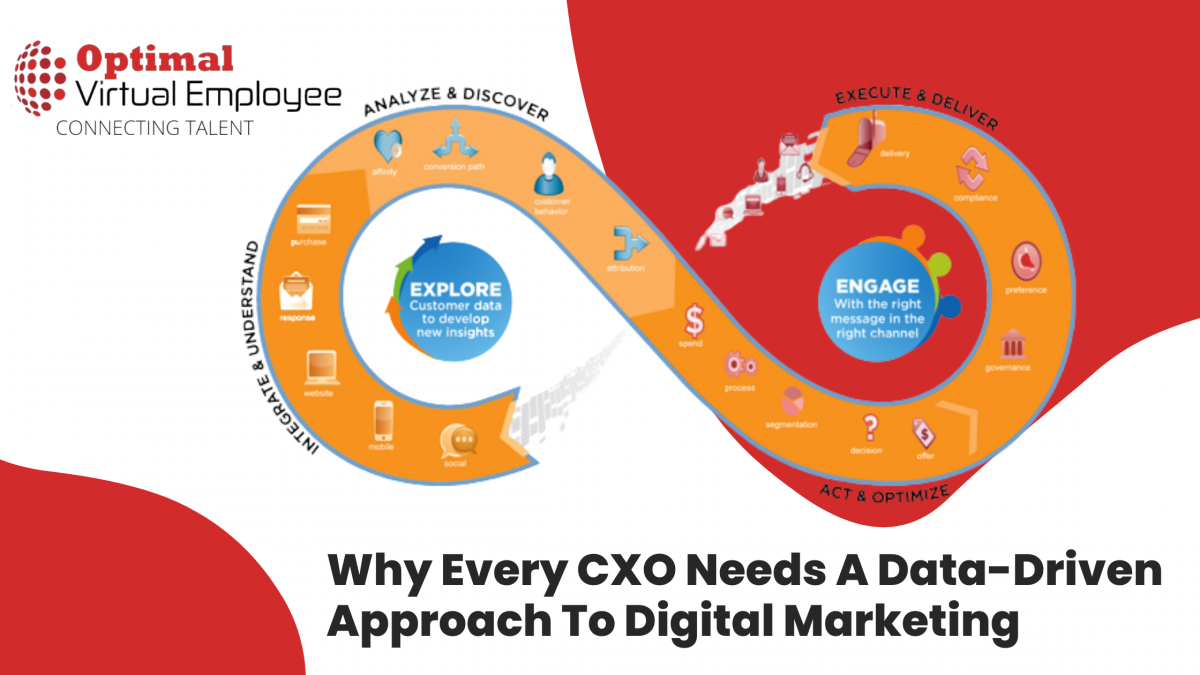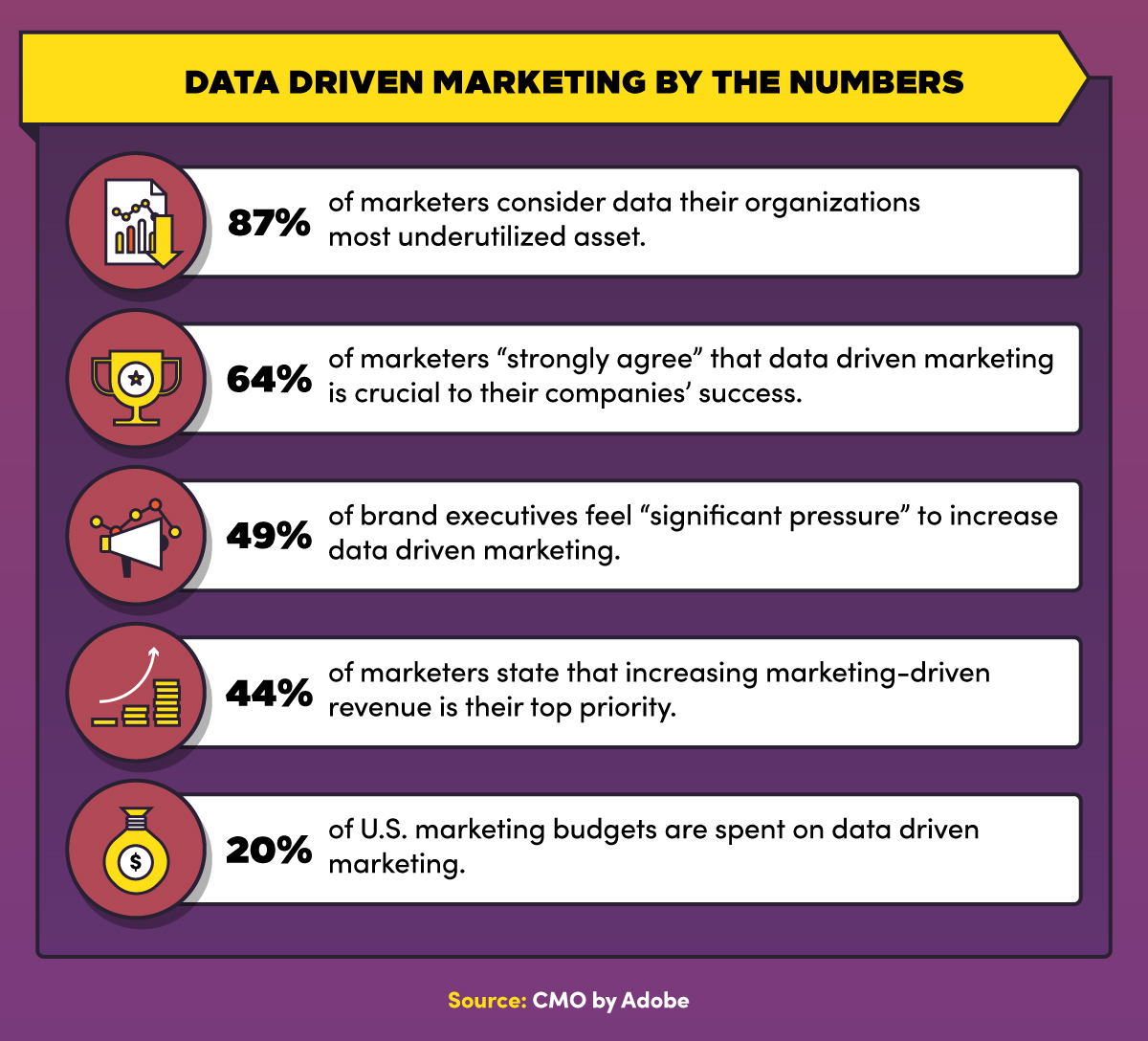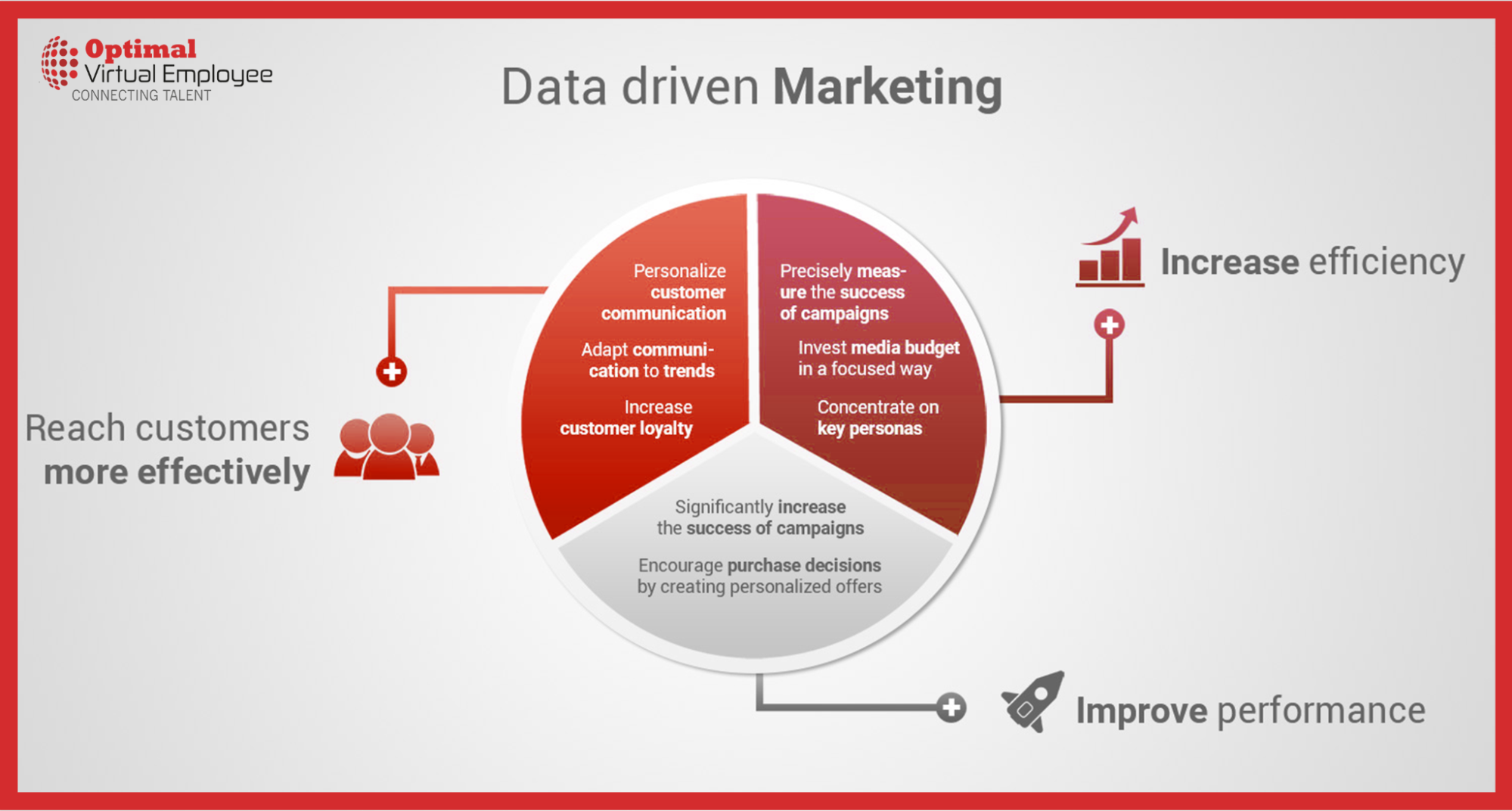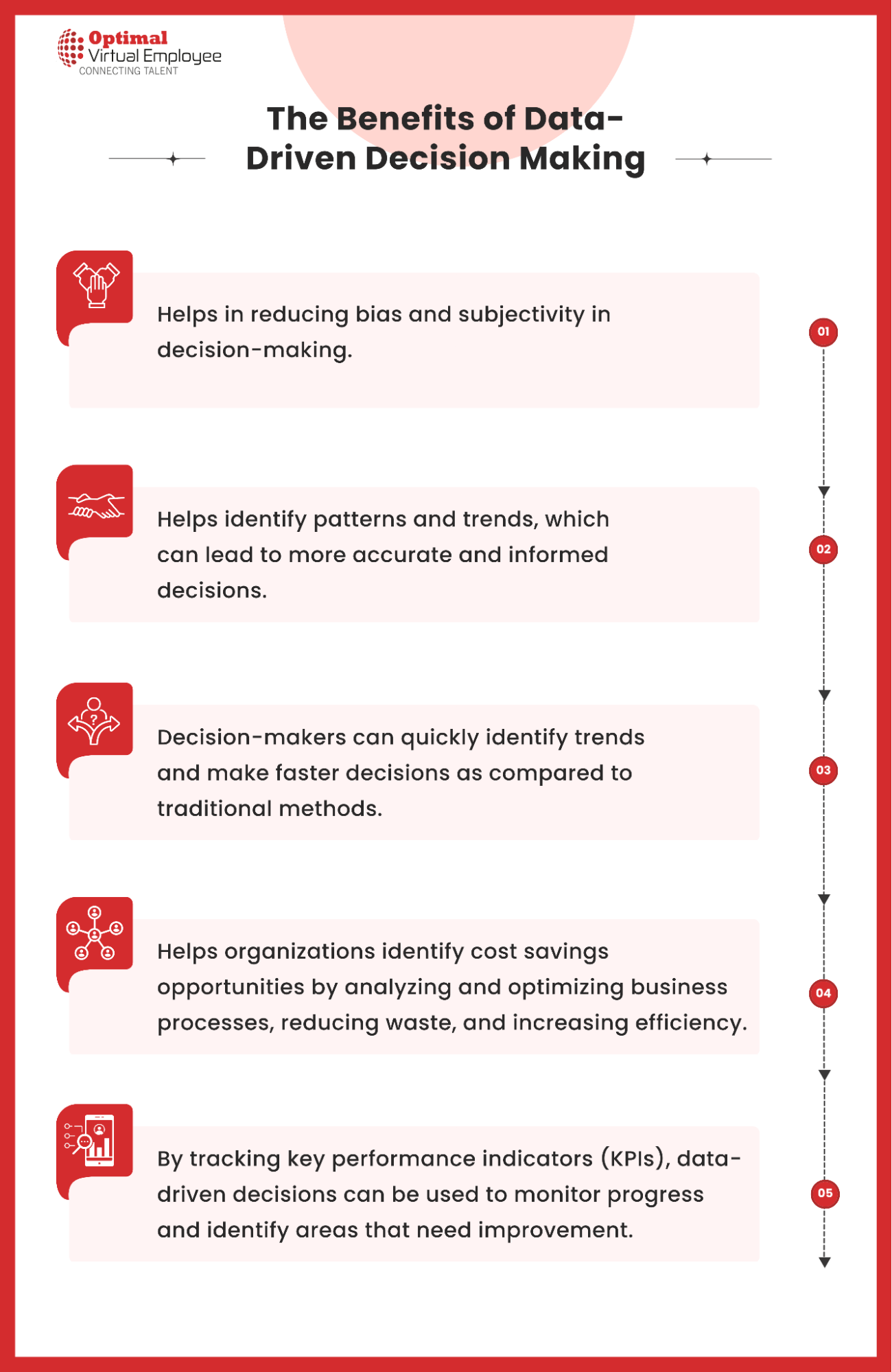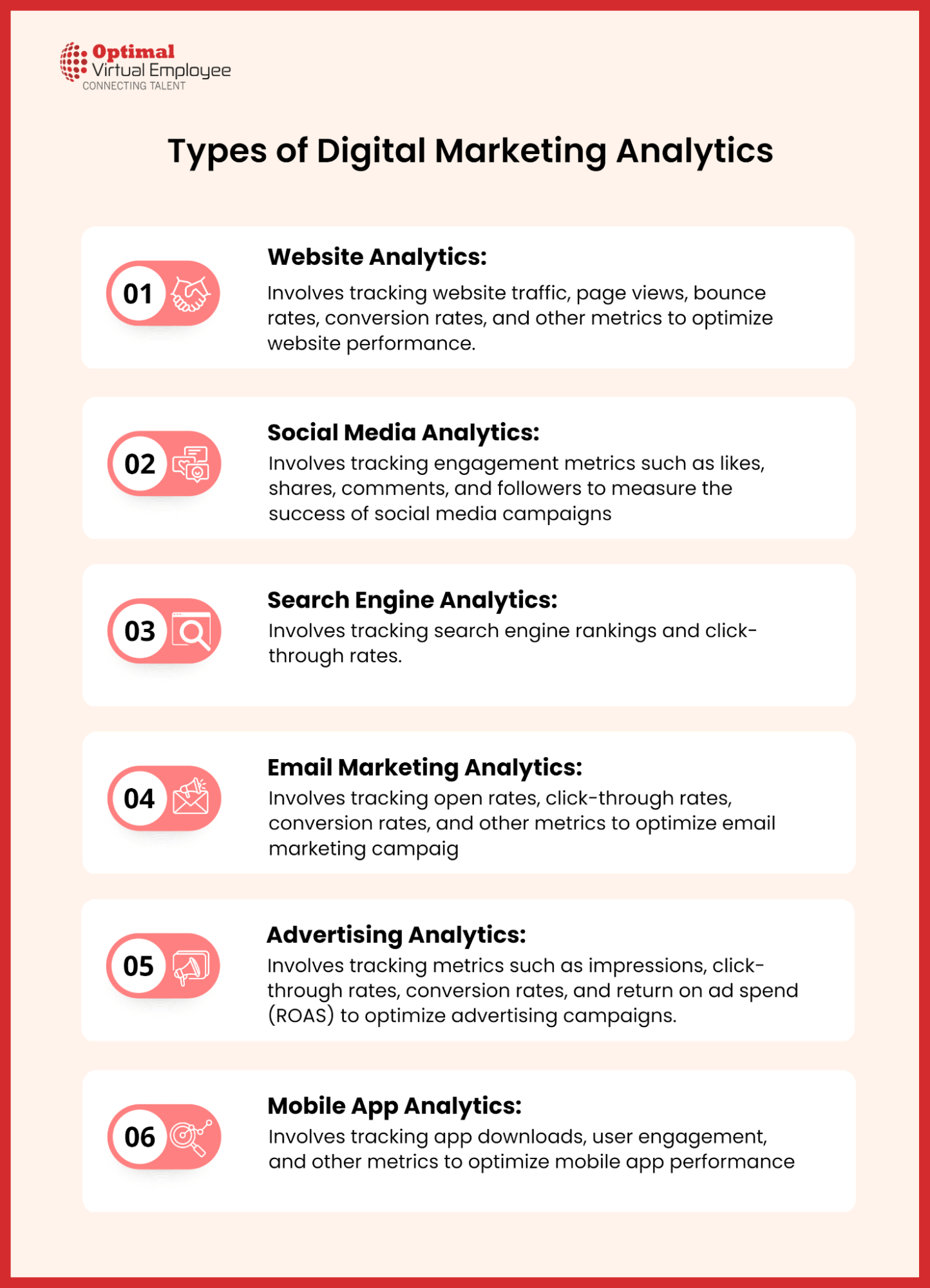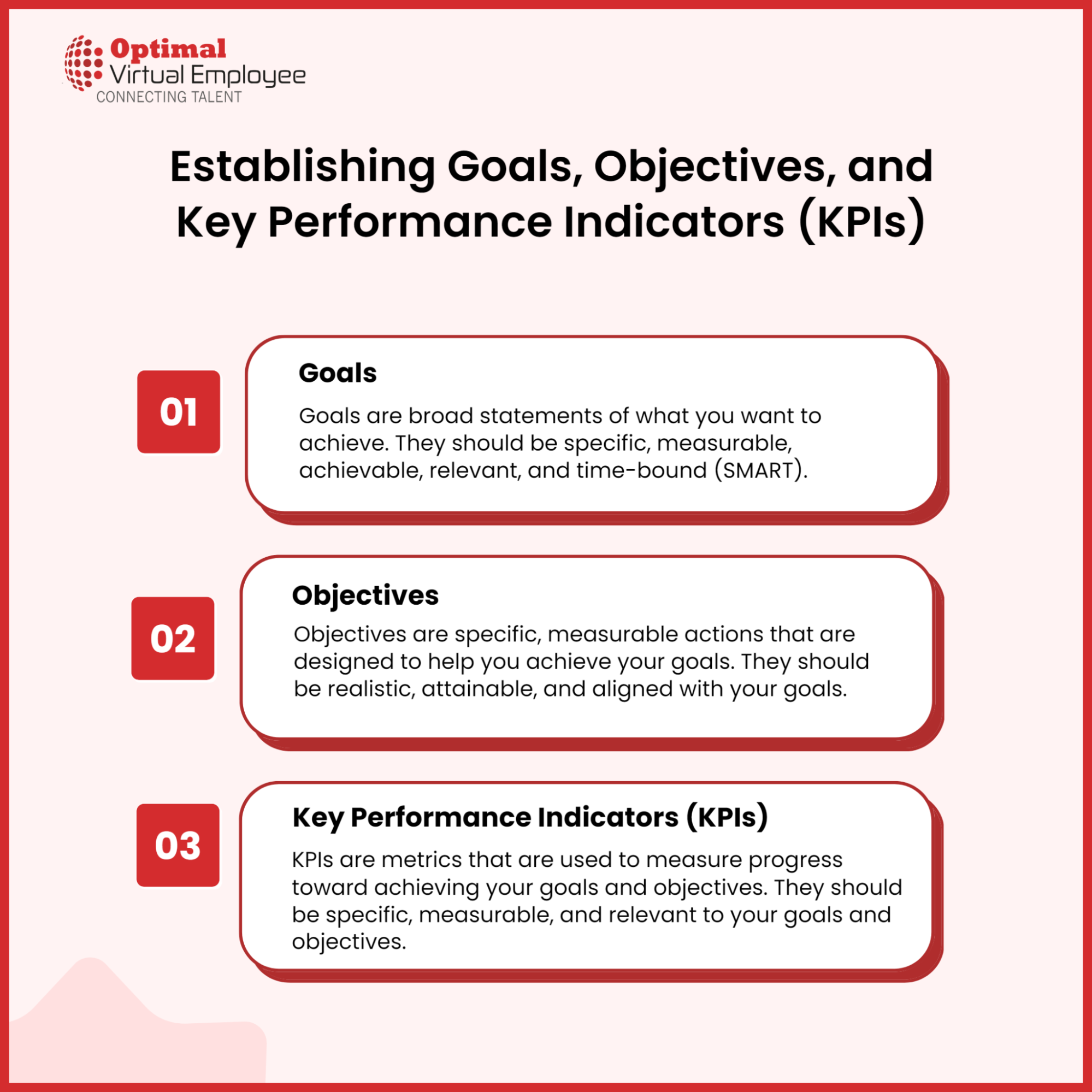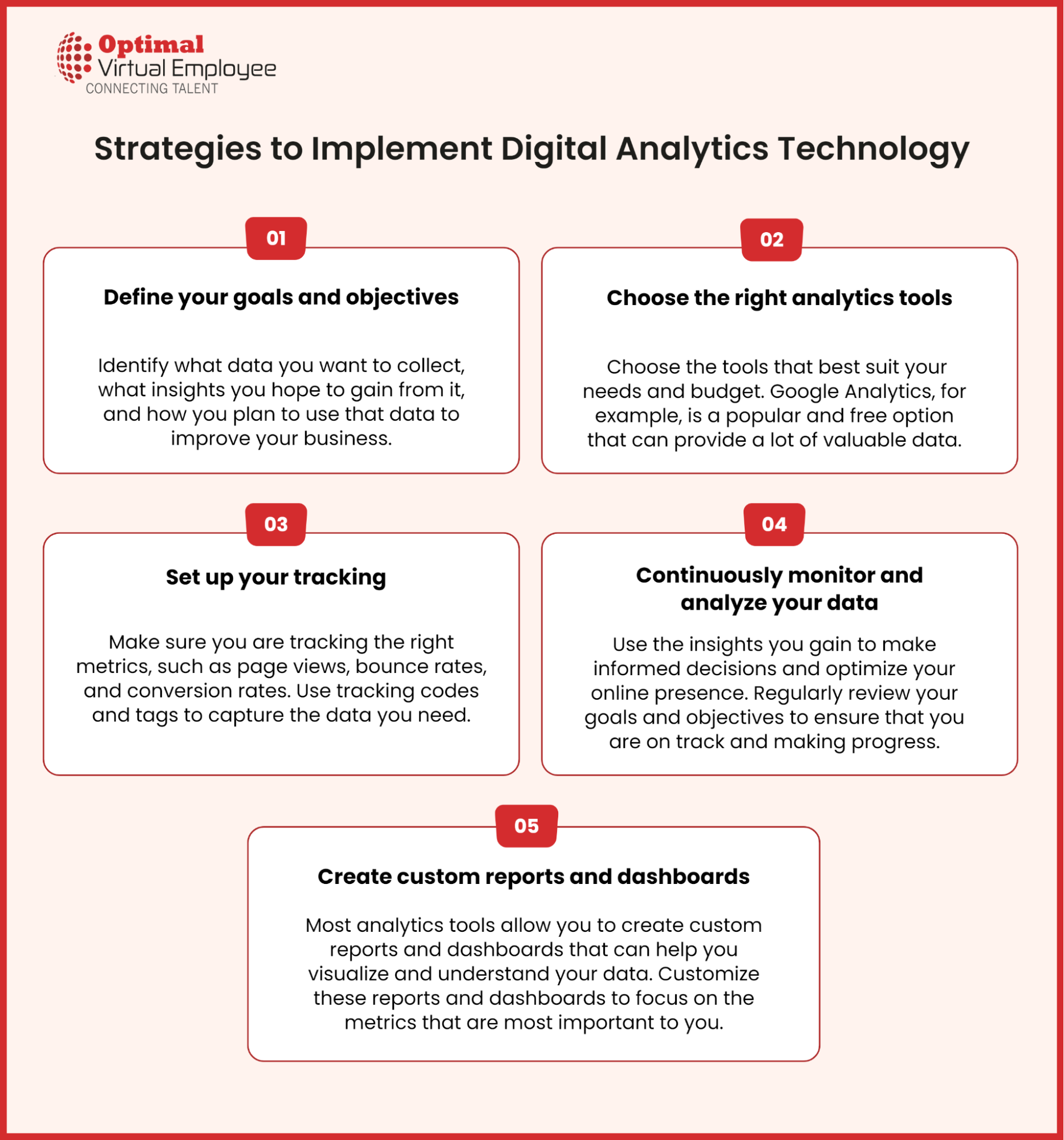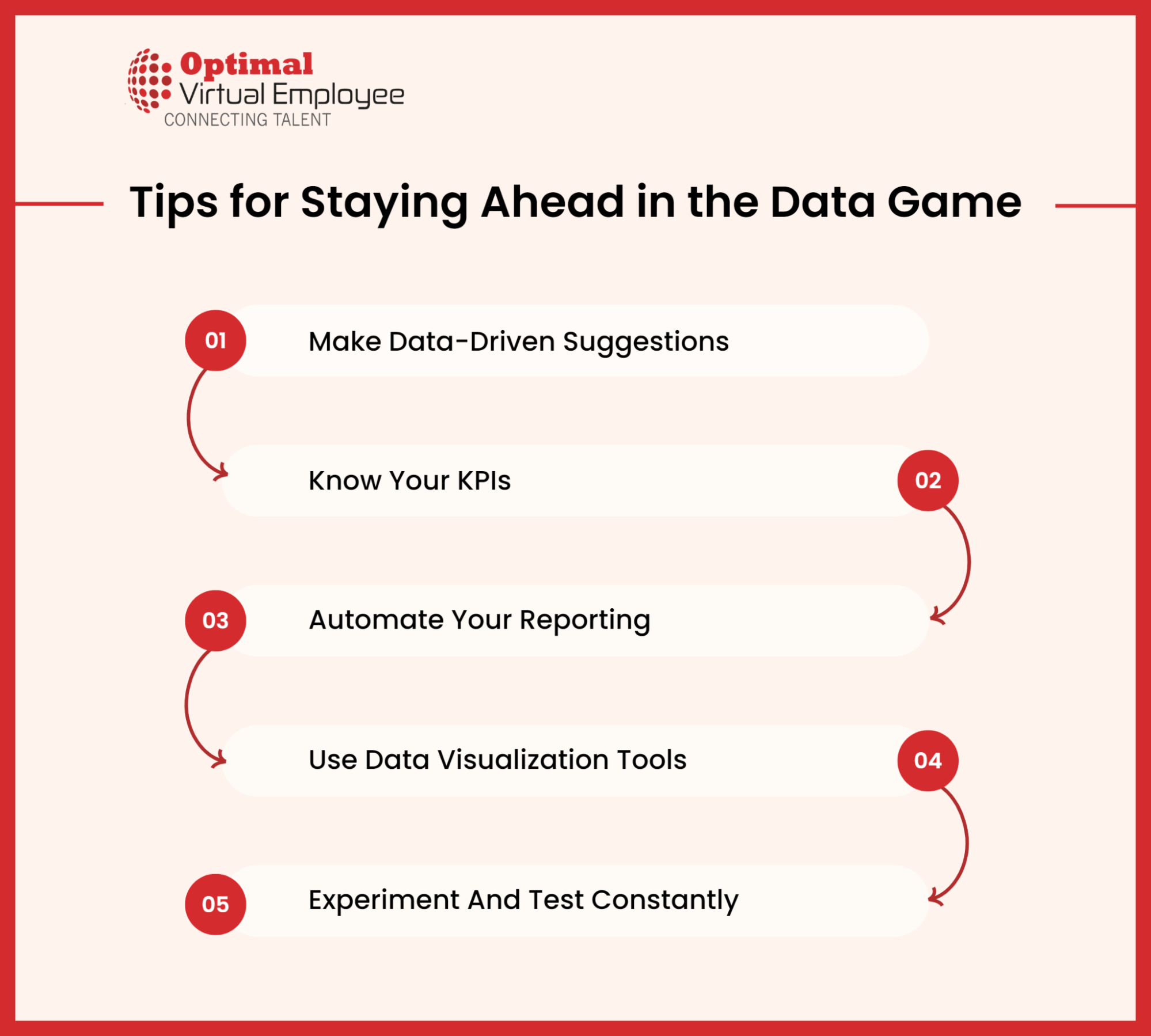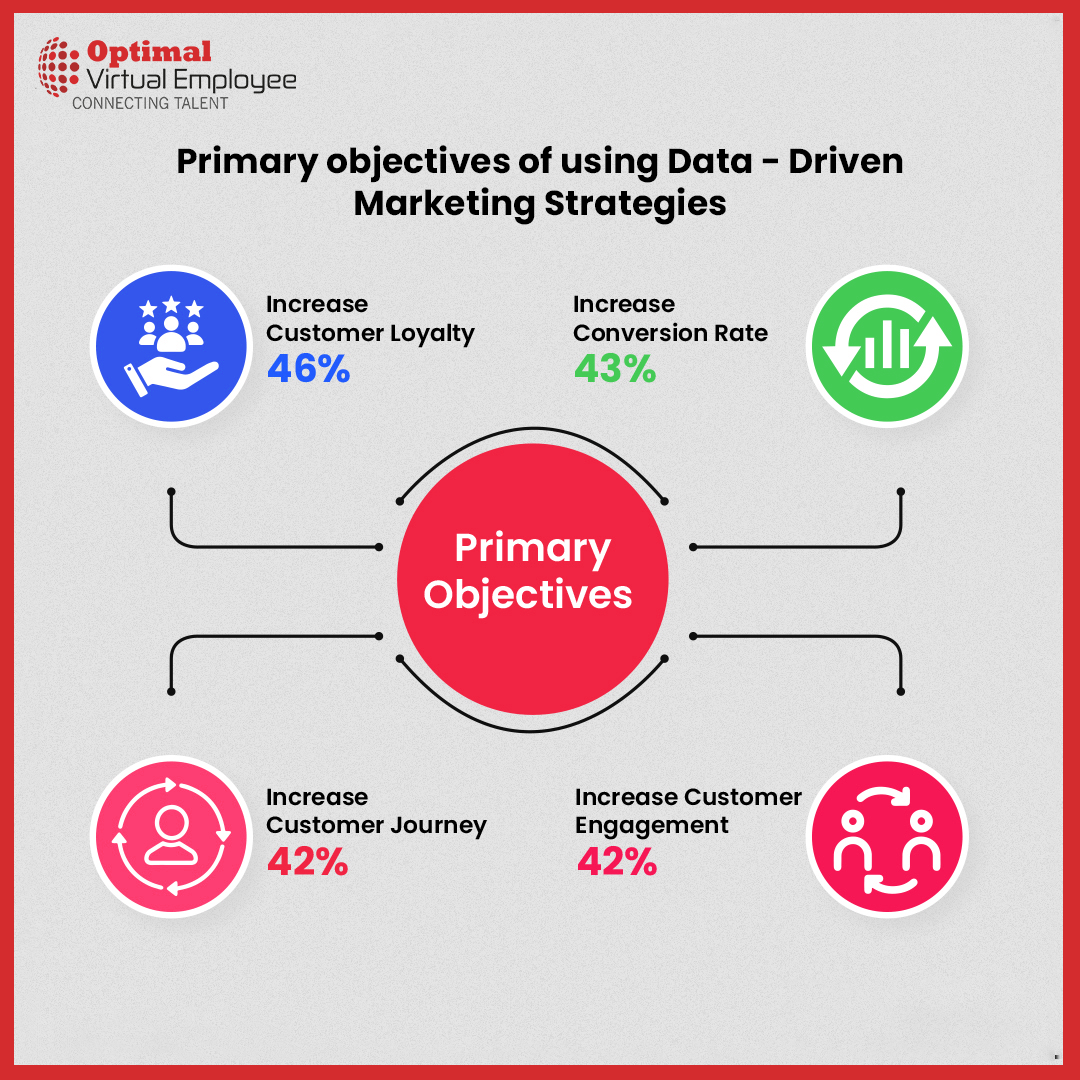A study by Forbes found that companies that embrace data-driven marketing are six times more likely to be profitable year-on-year than companies that don’t. Additionally, a survey by Teradata revealed that 78% of marketers believe that data-driven marketing is either “important” or “critical” to their success. This demonstrates the widespread recognition of the importance of data in modern marketing strategies.

In today’s digital age, businesses generate vast amounts of data daily. This data can be a goldmine for companies that know how to use it effectively. Yet, despite the enormous potential of data-driven marketing, many CXOs are still making decisions based on gut feelings or outdated assumptions. This can lead to missed opportunities, wasted resources, and, ultimately, a failure to meet business objectives.
Have a look at these statistics:
– According to a survey by Forbes Insights, 64% of marketing executives “strongly agree” that data-driven marketing is crucial to success in a hyper-competitive global economy.
– A study by McKinsey & Company found that companies that use customer analytics extensively are more likely to generate above-average profits.
– In a survey of over 500 marketers by the Winterberry Group, 92% of respondents said that data is essential to their marketing efforts, and 63% said they planned to increase their spending on data-driven marketing in the coming year.
These numbers demonstrate the importance of taking a data-driven approach to digital marketing. In this blog, we’ll explore why every CXO needs to prioritize data-driven decision-making and how they can use data to optimize their marketing strategies, improve customer experiences, and drive business growth.

The Benefits of Data-Driven Decision Making
Data-driven decision-making uses data to decide how to allocate resources to achieve a desired outcome. The benefits of data-driven decision-making include improved accuracy, increased efficiency, and greater transparency.
– Improved accuracy: With access to accurate data, you can make more informed decisions that are more likely to lead to the desired outcome. This is because you can identify trends and patterns that you may not be able to see with the naked eye.
– Increased efficiency: When you can make accurate decisions quickly, you can save time and resources. You can avoid trial and error and allocate resources more effectively.
– Transparency:Data-driven decision-making creates a transparent trail of evidence that can be used to hold people accountable. This is important in organizations where there may be a lot of stakeholders with different agendas.
– Better customer service: Data-driven decision-making can help you identify customers’ wants and needs, improving customer service and satisfaction.
– Identification of new trends: Data-driven decision-making allows you to identify patterns in the data that may not be obvious to the naked eye. This can help organizations stay ahead of the competition by keeping an eye on emerging trends in their industry.
Understanding the Types of Digital Marketing Analytics
Digital marketing is constantly evolving, and one of the most significant changes has been the increasing importance of analytics. Businesses can no longer rely on gut instinct or intuition to guide their marketing decisions—they need data to show them what’s working.
But with so many different types of digital marketing analytics, it can be challenging to know which ones are right for your business.
– Website Analytics: Website analytics tools like Google Analytics can give you insights into how people interact with your website. You can see how many people visit your site, how they got there, what pages they’re looking at, and how long they’re staying. This data can help you optimize your website for better conversion rates.
– Social Media Analytics: Social media platforms like Facebook and Twitter have their own built-in analytics tools that let you see how your content is performing. You can track engagement rates, reach, impressions, and clicks. This data can help you understand which type of content resonates with your audience and then adjust your strategy accordingly.
– Email Marketing Analytics: Email marketing platforms like MailChimp or Constant Contact offer detailed reporting on the performance of your email campaigns. You can see things like open rates, click-through rates, unsubscribe rates, and even emails with the best results. This data can help you understand what’s resonating with your audience and how to create better campaigns in the future.
– Content Performance Analytics: Content performance analytics tools like Moz or Screaming Frog let you track your content’s performance across multiple channels and websites. You can see page views, impressions, shares, and backlinks. This data can help you identify which pieces of content drive the most traffic and conversions, so you know where to focus your efforts going forward.
– Advertising Analytics: Platforms like Google Ads or Facebook Ads offer detailed reporting on the performance of your ad campaigns. You can see click-through rates, impression share, cost per click, and conversion rates. This data can help you determine which ads are doing well and adjust accordingly.
These are just a few different digital marketing analytics types available today. No matter what kind of business you run or the industry you’re in, having access to these powerful marketing tools can give you insights into what’s working for your brand and allow you to make informed decisions about the direction of your business.
Establishing Goals, Objectives, and Key Performance Indicators (KPIs)
What does your organization want to achieve? The first step in creating a data-driven approach to digital marketing is establishing clear goals and objectives. Once you understand your goals well, you can develop key performance indicators (KPIs) that will help you track progress and measure success.
Your KPIs should be aligned with your overall goals and objectives. For example, you might track metrics such as website traffic or social media engagement to increase brand awareness. If your goal is to drive conversions, you might track leads generated or sales completed.
Once you have established your goals, objectives, and KPIs, you must review your progress and make necessary adjustments regularly. Your data-driven approach should be flexible enough to change as your business evolves and new opportunities arise.
By setting clear goals, creating metrics to measure success, and regularly reviewing your data, you can ensure that your digital marketing efforts effectively drive business results.
Strategies to Implement Digital Analytics Technology
Digital marketing is constantly evolving, and data-driven approaches are increasingly becoming essential for success. As a result, Chief Experience Officers (CXOs) must understand digital analytics technology and how to use it effectively.
Several digital analytics technologies are available, and the right one for your organization will depend on your specific needs and goals. However, there are some general strategies that you can use to make sure that you’re getting the most out of your digital analytics technology.
Make sure that you have the correct data.
The first step is to ensure you’re collecting the correct data. This data should be comprehensive and cover all aspects of your digital marketing efforts. Without the correct data, you won’t be able to make informed decisions about your strategy or measure your results accurately.
Use multiple platforms.
Don’t rely on just one platform or tool for your digital analytics. Use multiple platforms to get a complete picture of what’s going on. This will help you identify patterns and trends that you might otherwise miss.
Use data visualization tools.
Data visualization tools can help you see relationships between data sets that would be difficult to spot otherwise. This can be extremely helpful in identifying opportunities and making better decisions about your strategy.
Experiment and test frequently.
Digital marketing is an ever-changing landscape, so it’s essential to experiment and test constantly. Make sure that you have structured processes in place to ensure that you’re taking advantage of new opportunities as they become available.
Invest in marketing automation tools.
Marketing automation tools can help automate some of the more tedious tasks associated with digital marketing, along with freeing up your time to focus on more strategic efforts. These tools can also help automate certain reporting aspects, making it easier to monitor the success of your campaigns.
Utilize predictive analytics technologies.
Predictive analytics technologies are designed to make better predictions about future events based on historical data. This information can be beneficial for creating online strategies and targeting specific audiences more effectively.
Monitor customer feedback loops for insights.
Monitoring customer feedback loops are a great way to get insight into what your customers are looking for regarding products, services, and experiences. This information can then be used to tailor your strategies and ensure they’re effectively meeting customer needs.
Integrating Data into Your Current and Future Digital Marketing Plan
As a Chief Experience Officer (CXO), you know that data is critical to success. After all, it’s the lifeblood of your company, and it drives every decision you make.
Now, more than ever, data plays a vital role in digital marketing. To succeed, you need a data-driven approach to your digital marketing plan. Here’s why:
– Data gives you insights into your customers that you wouldn’t otherwise have.
– Data lets you track your results and optimize your campaigns for better ROI.
– Data helps you personalize your marketing messages and content for each customer.
– Data can help you automate your marketing processes so you can focus on other things.
– Most importantly, data ensures your digital marketing plan constantly evolves and grows with your business. Without data, your project will quickly become outdated and less effective.
It’s no secret that the industry landscape changes rapidly, so to keep up with the competition and stay ahead of the curve, you must constantly adapt your digital marketing plan according to the latest data trends.
Tips for Staying Ahead in the Data Game
Here are some tips for staying ahead in the data game:
Make data-driven decisions:
This may seem obvious, but it’s worth reiterating: all decisions should be based on data. Whether you’re deciding which channels to focus on or what campaigns to run, always let data be your guide.
Know your KPIs:
It’s not enough to collect data – you must know what to do with it. That’s why it’s crucial to identify and track the right KPIs (key performance indicators). Only then can you start to understand what’s working and what isn’t.
Automate your reporting:
Reporting can be time-consuming, but it doesn’t have to be. Plenty of tools and platforms can automate reporting, making getting the insights you need easier and faster.
Use data visualization tools:
Data visualization tools like Tableau or Power BI can help you see patterns and trends you might miss if you were just looking at raw data. They can also make complex data sets easier to understand – which is always helpful when making decisions!
Experiment and test constantly:
The only way to stay ahead in the data game is to experiment and test your assumptions constantly. By running A/B tests and other experiments, you can validate (or invalidate) your hypotheses, giving you the data-driven insights you need to succeed.
Conclusion
Digital marketing is no longer a nice-to-have; it’s a necessity. To keep up with the competition, you need to have a data-driven approach to digital marketing. This means using data and analytics to make informed decisions and drive your strategy.
However, this can be difficult if you don’t have the right in-house tools or expertise. That’s where digital analytics comes in. An excellent digital analytics solution will help you collect and analyze data so that you can make better decisions about your digital marketing strategy.

– First, make sure the solution can collect the data you need. There’s no point in using a digital analytics solution that can’t track your essential KPIs.
– Second, ensure the solution is easy to use and provides actionable insights. The last thing you want is a complex tool that’s difficult to understand.
– Third, ensure the solution integrates with your other marketing tools and systems. This will make it easier to start and avoid disruptions later on.
Once you’ve found a digital analytics solution that meets these criteria, it’s time to start putting it to work. Use it to track your KPIs, measure your results, and adjust your strategy. With the right analytics, you can bridge the gap between business and technology and stay one step ahead of the competition.
